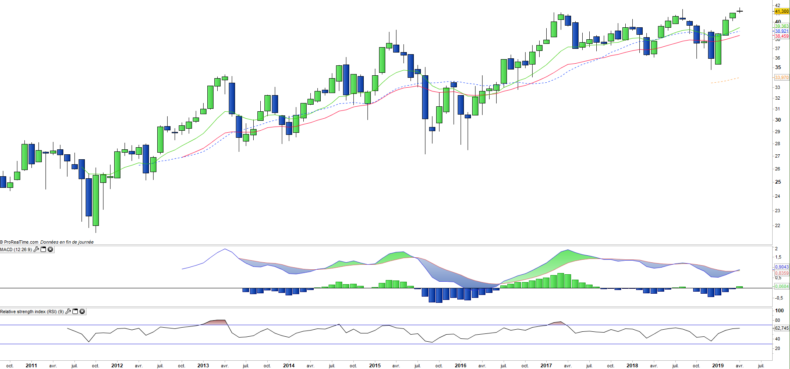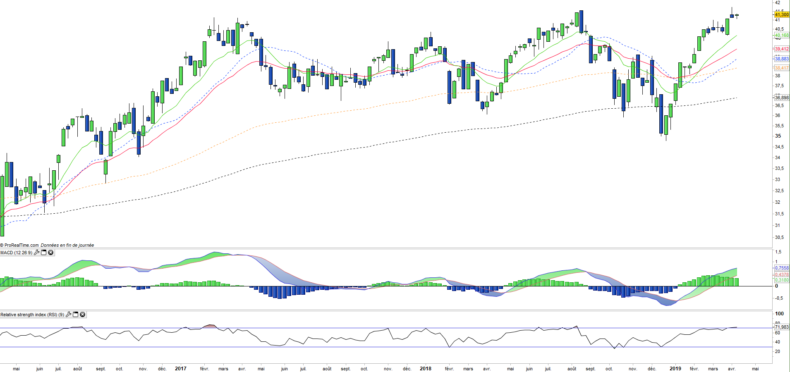Lyxor Australia (AU2) - 12/04/19
Short Term trend: Positive (90/100)
Long Term trend: Positive (100/100)
(scores computed by our proprietary algorithms - cf methodology)
Characteristics of the ETF
The ETF AU2 (Lyxor), created in 03/2010, replicates the S & P ASX200 index, which consists of the 200 largest Australian stocks that cover approximately 80% of the country's market capitalization.
The index is weighted by floating capitalization. The ETF's fees are slightly higher than the average of our sample and stand at 0.4% while the AUM amount to around 65M €.
The replication method is indirect (via a swap), the ETF is quoted in Euro and the dividend payment policy is by distribution.
Alternative ETFs: EWA ( iShares in USD)
Index & components
This index is very deep and covers the bulk of the market capitalization of the country, so it is a very good proxy of the Australian economy.
The first 10 stocks are mainly composed of banks, while financials make up c.32% of the index, the other strongly represented compartment is mining / materials for c.20%, which includes the giant BHP Billiton (7% of the index).
We see Australia as a growth vehicle, as it is the only country in the OECD that has not experienced a recession during the financial crisis as the economy has experienced 26 consecutive years of growth. Growth reached 2.4% in 2015, despite the fall in coal and iron ore prices, which had a strong impact on exports, and the trend was more or less similar in 2016,2017 and 2018 (+ 3%). This good performance can be explained by the broadening of the economy, following a relative slowdown due to the decline in Chinese demand for exports, particularly of minerals. The mining sector accounts for about 20% of GDP, but investments that have fallen due to falling prices are gradually recovering. Australia has other assets: a massive export of agricultural products, strong domestic demand and a robust financial sector.
Australia accelerates its integration with the Asia-Pacific region, while the country's main trading partners are Asia (China first), the United States and the European Union. Asia's share of trade with Australia is growing steadily. By 2014, Australia had signed a free trade agreement with China, in line with that agreement, Australia joined the Asian Investment Bank for Infrastructure, created by China in 2015.
So investing in the Australian index indirectly focuses on the development of the Asia (and China) zone through an Anglo-Saxon liberal country that is highly financialized but has a lot of natural resources, while population remain limited (approximately 25 million inhabitants). Australia's GDP is around $ 1,300 bn and roughly equal to the level of Spain or Russia, while per capita GDP is one of the highest in the world. The index is fairly volatile, but is steadily growing. After a sharp increase of 13.1% in 2016 and 5.3% in 2017, the index recorded a 8.4% decrease in 2018 in the wake of the correction of the major world indices, but rebounded by c.15% in 2019 in the wake of the mining sector while the banking sector (mainly Commonwealth Bank of Australia and Westpak Banking) remains weak because of long termrates which remain very low.
The Australian economy remains very dynamic despite its high exposure to China and commodities, in a context of trade war with uncertain consequences.
Technical analysis
Monthly analysis
The monthly chart shows a new attack of the historic ceiling located at around 42 €. This attack occurs in better conditions than the previous times, especially in 2017 while prices reached these levels after a significant prices increase and overbought situation. The bullish reversal of the MACD bodes well for exceeding this ceiling, which would release a significant potential for the future. A new surge is probably beginning.
Weekly analysis
On the weekly chart, there is an attempt to exceed the 2-year major resistance. Prices posted new highs, but the ceiling bullish break-out will be confirmed only if a weekly closing at above € 42.5 / € 43 were to occur. The oscillators are in the high zone, but without being in a overbought’s situation that would make incompatible a bullish acceleration. The resistance breaking is the most likely scenario.
Theme
AU2 is a UCITS ETF, listed in EUR, which seeks to replicate the S&P/ASX 200 Net Total Return index (200 australian companies)
Characteristics
| Inception date | 26/03/10 |
| Exepense ratio | 0,40% |
| Benchmark | S&P/ASX 200 Net Total Return |
| Ticker | AU2 |
| Issuer | Lyxor |
| UCITS | Yes |
| EU-SD Status | Out of scope |
| Currency | € |
| Exchange | Euronext Paris |
| Assets Under Management | 63 M€ |
| Dividends | Distribution |
| PEA (France) | No |
| SRD (France) | Yes |
| Currency risk | Yes |
| Number of Holdings | 200 |
| Risk | 3/5 |
Country Breakdown
| Australia | 95% |
| United Kingdom | 3% |
| New Zealand | 1% |
| USA | 1% |
Sector Breakdown
| Financials | 32% |
| Materials | 19% |
| Health Care | 8% |
| Industrials | 8% |
| Consumer Staples | 7% |
| Real Estate | 6% |
| Energy | 6% |
| Others | 13% |
Principales composantes
| Commonwealth Bank | 8% |
| BHP Billiton | 7% |
| CSL LTD | 6% |
| Westpac Banking Corp | 5% |
| Aust & NZ Banking Group | 5% |
| National Australia Bank | 4% |
| Macquarie Group | 3% |
| Woolworths | 2% |
| Telstra Corp | 2% |
| Wesfarmers | 2% |


